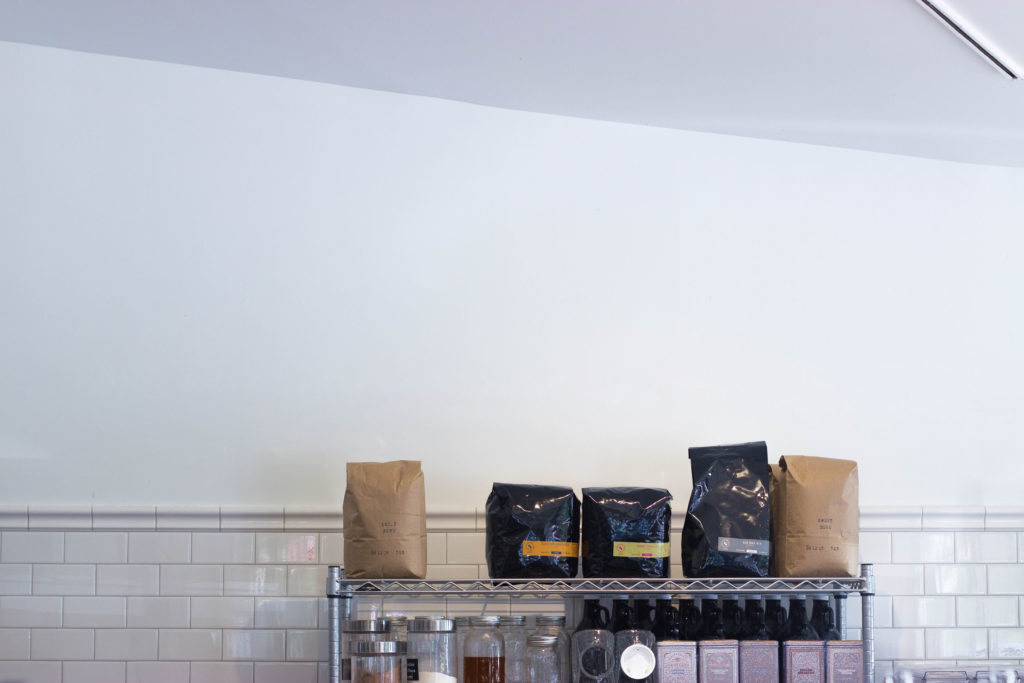FREE SHIPPING on all retail orders of $29+

[spb_single_image image=”16969″ image_size=”full” frame=”noframe” lightbox=”no” link_target=”_self” fullwidth=”no” width=”1/2″ el_position=”first”][/spb_single_image] [spb_text_block pb_margin_bottom=”no” pb_border_bottom=”no” width=”1/2″ el_position=”last”]
Many cafe owners know that there is a certain loyalty exhibited when a customer purchases beans from your cafe to make at home.
It’s a proud moment when a customer enjoys quality coffee to the extent that they are compelled to bring your product into their home. One of the main reasons we roast with such a meticulous schedule is so that we can provide the freshest, highest quality beans for your customers. That isn’t so say that there aren’t challenges with preserving the quality that we desire to roast into your beans.
The way that cafes choose to package the roasted coffee fruit, can greatly impact the quality that you offer in your take home sack of beans! Before we get into the different packages, it’s important to understand exactly how coffee goes bad.
[/spb_text_block] [blank_spacer height=”30px” width=”1/1″ el_position=”first last”] [spb_text_block title=”Freshness window” pb_margin_bottom=”no” pb_border_bottom=”no” width=”1/1″ el_position=”first last”][/spb_text_block] [spb_text_block pb_margin_bottom=”no” pb_border_bottom=”no” width=”1/1″ el_position=”first last”]
Our roasted beans are meant to be ground and tamped within 2 weeks. Our fresh green bean’s chemical composition start to change as soon as we roast them. Once roasted, an oxidation process begins at a slow rate, as soon as air hits the beans. It’s essentially the same process that an apple turns brown after you cut it open. [1]
Once the beans begin to oxidate, flavors, oils and aromatics are released (all the good stuff that makes up your coffee’s flavor). The longer that you can prolong this air-exposed oxidation, the longer you can preserve the flavors roasted into the beans. [2]
[/spb_text_block] [blank_spacer height=”100px” width=”1/1″ el_position=”first last”] [spb_text_block title=”Gusset Bag” pb_margin_bottom=”no” pb_border_bottom=”no” width=”1/1″ el_position=”first last”][/spb_text_block] [spb_text_block pb_margin_bottom=”no” pb_border_bottom=”no” width=”2/3″ el_position=”first”]
These bags can stand on their own when they have coffee inside, but tend to not have as many flavor saving options. They are considered a more traditional style of bag, can be the most cost effective of the bunch, and may have a plastic roll over tie to try and save some flavor.
[/spb_text_block] [spb_single_image image=”16964″ image_size=”full” frame=”noframe” lightbox=”no” link_target=”_self” fullwidth=”no” width=”1/3″ el_position=”last”][/spb_single_image] [blank_spacer height=”30px” width=”1/1″ el_position=”first last”] [spb_text_block title=”Stand Up Pouch” pb_margin_bottom=”no” pb_border_bottom=”no” width=”1/1″ el_position=”first last”][/spb_text_block] [spb_single_image image=”16966″ image_size=”full” frame=”noframe” lightbox=”no” link_target=”_self” fullwidth=”no” width=”1/3″ el_position=”first”][/spb_single_image] [spb_text_block pb_margin_bottom=”no” pb_border_bottom=”no” width=”2/3″ el_position=”last”]
While the other three options most certainly do not look cheap, this bag style tends to exhibit a more modern and sleek design. They are similar to a flat pouch bottom, but have a round bottom. They are easy to find if you are one who would want to custom design your bag.
[/spb_text_block] [blank_spacer height=”30px” width=”1/1″ el_position=”first last”] [spb_text_block title=”Flat bottom pouch” pb_margin_bottom=”no” pb_border_bottom=”no” width=”1/1″ el_position=”first last”][/spb_text_block] [spb_text_block pb_margin_bottom=”no” pb_border_bottom=”no” width=”2/3″ el_position=”first”]
This is similar to the Stand up pouch, but more square on the bottom. These can come with a gas release valved (used to release co2 from the beans oxidizing), or a reseal zip option. These are great as they can stand out on a shelf and roll up into rectangles to stack well. These are considered a more modern way of packaging beans.
[/spb_text_block] [spb_single_image image=”16968″ image_size=”full” frame=”noframe” lightbox=”no” link_target=”_self” fullwidth=”no” width=”1/3″ el_position=”last”][/spb_single_image] [blank_spacer height=”30px” width=”1/1″ el_position=”first last”] [spb_text_block title=”Pillow Bags” pb_margin_bottom=”no” pb_border_bottom=”no” width=”1/1″ el_position=”first last”][/spb_text_block] [spb_single_image image=”16967″ image_size=”full” frame=”noframe” lightbox=”no” link_target=”_self” fullwidth=”no” width=”1/3″ el_position=”first”][/spb_single_image] [spb_text_block pb_margin_bottom=”no” pb_border_bottom=”no” width=”2/3″ el_position=”last”]
These bag types are more often than not used for single serving sizes. They can come with a clear sleeve on the front and do not come with many frills and fancy features to keep in freshness. These could also be used for more commercial use cases where someone would dump the entire lot of beans into a grinder (knowing they will use all of them that day). These bags can be extremely cost effective as well.
[/spb_text_block] [blank_spacer height=”30px” width=”1/1″ el_position=”first last”] [spb_text_block pb_margin_bottom=”no” pb_border_bottom=”no” width=”1/1″ el_position=”first last”]
There are so many options, size, style features when it comes to customizing bags. Hopefully next time you will be more informed on how you can educate your customers on keeping their cups fresh.
[/spb_text_block]
Call:
888-612-5050
Office Hours:
Mon-Thu: 8a-5p CT
Fri: 8a-4p CT
Office & Roastery:
2781 99th St
Urbandale, IA 50322
© Copyright Friedrichs Coffee 2023. All Rights Reserved.
Privacy Policy | Terms of Service | Refund Policy
Web Design and Development by Saltech Systems